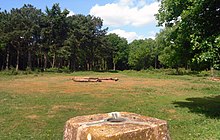Hurst Hill, Oxfordshire
| Site of Special Scientific Interest | |
 | |
| Location | Oxfordshire |
|---|---|
| Grid reference | SP 476 041[1] |
| Interest | Biological Geological |
| Area | 20.6 hectares (51 acres)[1] |
| Notification | 1986[1] |
| Location map | Magic Map |
Hurst Hill or Cumnor Hurst is a 20.6-hectare (51-acre) biological and geological Site of Special Scientific Interest west of Oxford in Oxfordshire.[1][2] It is a Geological Conservation Review site.[3]
The site is owned by All Souls College, Oxford,[4] and its mosses and liverworts have been monitored for more than fifty years. The hill is also important geologically. In 1879 a fossil of a Camptosaurus prestwichii, a large herbivorous dinosaur dating to the Upper Jurassic 153 million years ago, was found on the site.[5] The fossil belongs to a typically North African genus, and provides evidence of a land bridge across the proto-Atlantic in the Late Jurassic.[6]
The hill is mentioned in Matthew Arnold's poem The Scholar Gipsy.[4]
References
[edit]- ^ a b c d "Designated Sites View: Hurst Hill". Sites of Special Scientific Interest. Natural England. Retrieved 6 April 2020.
- ^ "Map of Hurst Hill". Sites of Special Scientific Interest. Natural England. Retrieved 6 April 2020.
- ^ "Chawley Brickpits, Cumnor Hurst (Jurassic - Cretaceous Reptilia)". Geological Conservation Review. Joint Nature Conservation Committee. Archived from the original on 8 August 2019. Retrieved 26 February 2020.
- ^ a b Hopkins, Gerard Manley (2015). The Collected Works of Gerard Manley Hopkins. Oxford University Press. p. 371, n. 625.
- ^ "Dinosaurs in the Museum" (PDF). Oxford University Museum of Natural History. Archived from the original (PDF) on 13 January 2021. Retrieved 6 April 2020.
- ^ "Hurst Hill citation" (PDF). Sites of Special Scientific Interest. Natural England. Retrieved 6 April 2020.
External links
[edit]51°44′00″N 1°18′40″W / 51.73333°N 1.31111°W
